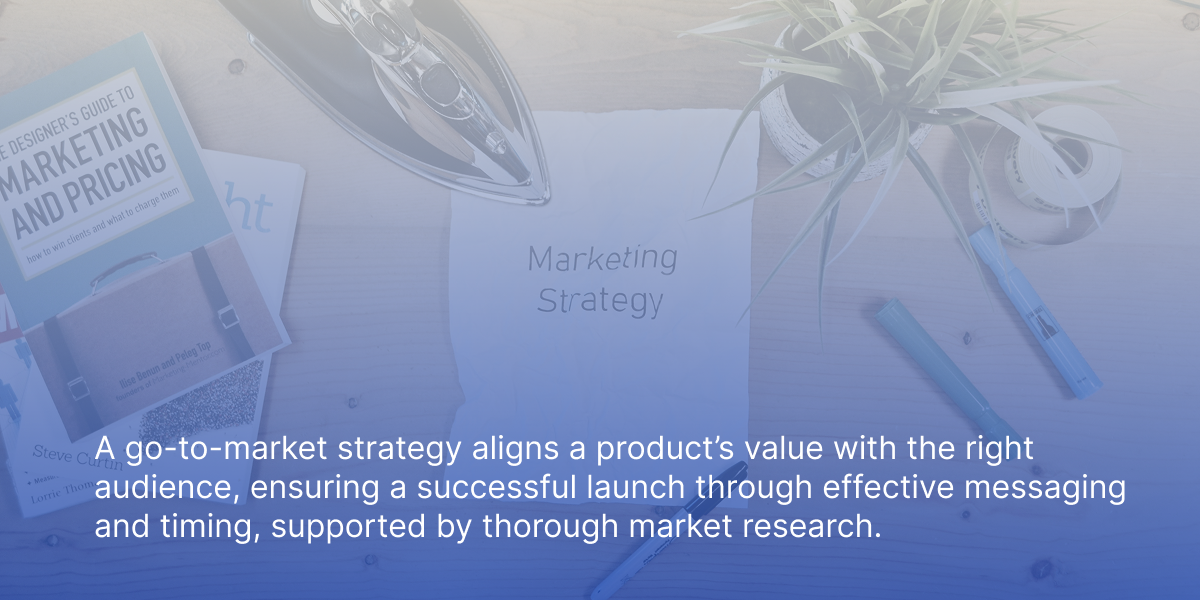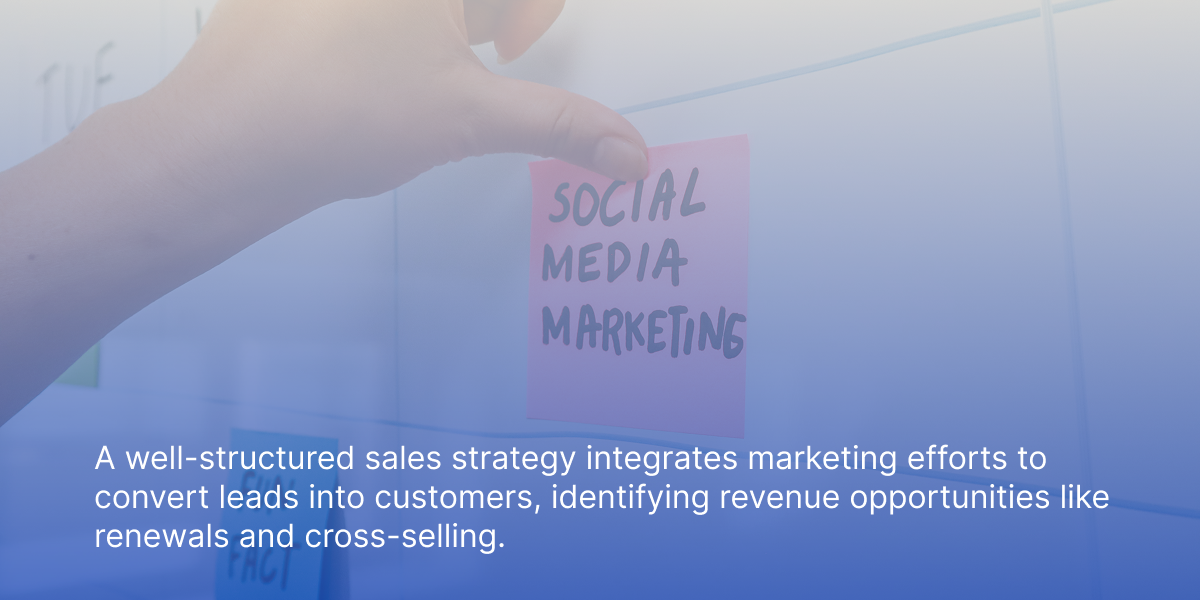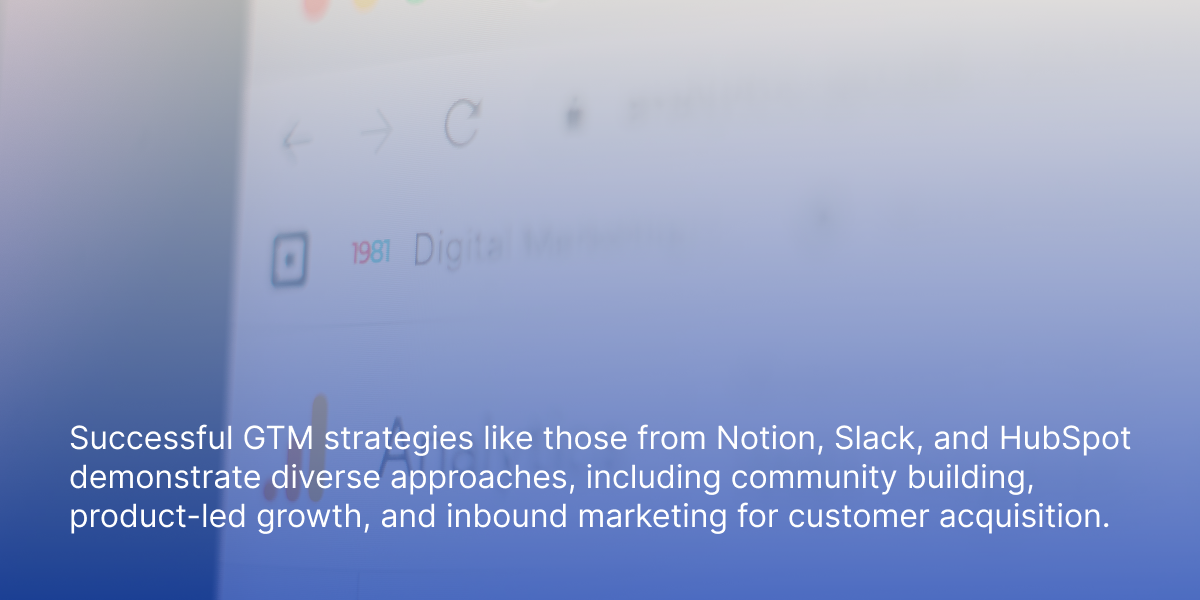A go-to-market strategy framework helps you launch a product effectively by targeting the right audience with the right message. This guide covers the essential steps, examples, and templates to build your GTM strategy.
Key Takeaways
- A successful go-to-market strategy requires comprehensive market research, target audience identification, and a unique value proposition to align the product with customer needs.
- Aligning sales and marketing teams through shared analytics and collaborative goal-setting is crucial for maximizing effectiveness and achieving a cohesive go-to-market approach.
- Utilizing templates and structured frameworks can streamline the development and implementation of a go-to-market strategy, ensuring all critical components are thoroughly addressed.
Understanding the Go-To-Market Strategy Framework
A go-to-market strategy is a comprehensive framework designed to align a product’s value proposition with the right audience through targeted initiatives. Its primary purpose is to ensure a successful product launch by reaching the right people with effective messaging and timing. This marketing strategy not only helps in managing expectations but also in mitigating risks associated with product launches, such as mistargeting the audience or entering a saturated market.
Achieving product-market fit is a crucial aspect of a market gtm strategy. It involves ensuring that the product resonates well within its intended market segment, driving organic growth and increasing the chances of a successful launch. A well-structured go to market gtm strategy helps businesses differentiate from competition, attract customers, and build a strong brand identity.
Without proper planning, even the most innovative products can struggle to find their place in the market. Understanding and implementing a comprehensive marketing plan and go-to-market strategy is essential for any business looking to maximize its impact in new markets and ensure long-term success. Additionally, effective go to market strategies can further enhance these efforts.
Key Components of an Effective GTM Strategy
An effective go-to-market strategy is built on several key components that work together to create a cohesive and targeted approach. These components include thorough market research, identifying the target audience, and crafting a unique value proposition. Each element plays a crucial role in addressing customer needs and utilizing appropriate sales and marketing channels to reach your goals.
Market research serves as the foundation for a successful GTM strategy. It is essential for understanding the market and making informed decisions. It involves understanding industry trends, customer preferences, and competitive dynamics to guide product development and marketing efforts. Identifying the right target audience is essential for faster market penetration and user adoption, as it allows you to tailor your messaging and positioning to resonate with specific customer segments.
Crafting a unique value proposition is another critical component. It communicates how your product uniquely solves customer problems compared to competitors, adding value and persuading your audience to choose your solution, giving you a competitive advantage. By integrating these elements into your GTM strategy, you can create a comprehensive plan that drives growth and success.
Market Research
Thorough market research is the cornerstone of any successful go-to-market strategy. It involves identifying industry trends and customer preferences, which directly influence product development and marketing efforts. To ensure there is market demand for your product and that competition is manageable, market research must be conducted meticulously as part of your GTM strategy.
Various resources, such as industry reports, customer surveys, and competitor analyses, can be leveraged to gather valuable insights. Techniques like market and customer research are essential for identifying user pain points and tailoring your strategies accordingly. These insights guide product development and marketing efforts, ensuring that your strategies are aligned with customer needs.
Competitive analysis is also vital in this process. It helps identify your direct and indirect competitors, their strengths and weaknesses, and the gaps and opportunities your SaaS solution can address within the competitive landscape. User feedback is crucial during market research, as it allows you to adjust your strategies and improve your product offerings based on real customer experiences.
Identifying Target Audience
Identifying the right target audience is critical for the success of your go-to-market strategy. One effective way to achieve this is by developing detailed buyer personas. These personas provide insights into customer motivations, challenges, and decision-making processes, allowing you to tailor your marketing efforts more effectively. For instance, a buyer persona for a customer support platform could be the head of customer support, dealing with training new agents and managing increasing ticket volumes.
The Ideal Customer Profile (ICP) is another important tool. It focuses on firmographic, environmental, and behavioral attributes, driving efficient messaging, marketing, and sales efforts. The development of ICP should be an ongoing process, influenced by customer behavior, competitive dynamics, and market shifts. Segmenting markets based on factors such as:
- Size
- Growth potential
- Willingness to pay
- Competition
- Alignment with business goals ensures that your strategies are targeted and effective.
B2B audiences can be segmented using factors such as industry, size, location, and individual roles. Understanding the evolution of these target segments allows businesses to refine their audience identification process continuously. By accurately identifying and understanding your target audience, you can create more resonant and effective marketing strategies that drive customer acquisition and retention.
Crafting a Unique Value Proposition
A unique value proposition is vital in distinguishing your product from competitors and addressing customer pain points. It communicates how your product uniquely solves customer problems and adds value. A strong value proposition should be concise, memorable, and focused on customer benefits.
Crafting an effective value proposition involves highlighting specific challenges faced by your audience and how your product addresses these issues. Value-based messaging helps persuade the audience to consider your solution over competitors by emphasizing the unique benefits provided. Agitating the pain point effectively in your messaging establishes relevance and urgency.
Consistency in messaging strategy is crucial while addressing customer pain points and highlighting unique product benefits. Testing different versions of your messaging can help identify what resonates best with your target audience, ensuring that your value proposition is compelling and effective.
Developing Your Sales Strategy
Developing a robust sales strategy is a critical component of a successful go-to-market plan. A good GTM strategy achieves alignment across teams, reduces risks of misalignment, optimizes resource use, and maximizes revenue opportunities. For new product launches, especially in a fast-paced ecosystem like SaaS, a well-defined saas gtm strategy is crucial for iterative improvements and scaling.
Creating a successful sales strategy involves a structured process that integrates various elements of your GTM strategy. This includes combining marketing and sales strategies to effectively convert leads into paying customers. Identifying revenue opportunities, such as renewals, cross-selling, and upselling, is key to developing an effective sales strategy.
To enhance your sales strategy, consider the following key points:
- Brainstorm ways to identify the best-fit customers.
- Analyze the sales cycle to shorten the conversion time between each stage, optimizing the sales funnel.
- Align sales teams with marketing, customer success, and product teams to execute an effective sales strategy.
Choosing the Right Sales Model
Choosing the right sales model is foundational to the success of your go-to-market strategy. There are four common sales strategies:
- Self-service
- Inside sales
- Field sales
- Channel model
Field sales models are essential for closing significant enterprise deals but involve higher costs and longer cycles. This model typically includes a full sales organization focused on large enterprise deals.
The inside sales model is effective for medium-complexity and price products, with a typical sales cycle ranging from a few weeks to a few months. On the other hand, the self service model is best suited for straightforward products with lower price points, providing a short sales cycle. Freemium models can also effectively attract new users by allowing them to experience the product with limited features before commitment.
Selecting the appropriate business model depends on your product complexity, pricing, and target market. By aligning your sales approach with these factors, you can optimize your sales efforts and drive better results.
Aligning Sales and Marketing Teams
Aligning sales and marketing teams is crucial for the cohesive execution of a marketing team go-to-market strategy. When these teams work in harmony, it enhances the efficiency and effectiveness of marketing and sales efforts. For a successful GTM strategy, it’s essential to align not only sales and marketing but also product development and customer support teams to ensure a unified sales and marketing alignment approach.
One effective method for aligning these teams, including customer success teams, is the use of shared analytics dashboards. These tools provide real-time insights and metrics, fostering transparency and collaboration between sales and marketing efforts. Additionally, collaborating on definitions and thresholds for Marketing Qualified Leads (MQLs) and Sales Qualified Leads (SQLs) can help align goals and expectations.
A well-coordinated approach ensures that both teams work towards common objectives rather than in opposite directions. Including a dedicated sales team and marketing teams in the GTM strategy development process promotes a sense of ownership and commitment, leading to better execution and results.
Selecting Marketing Channels
Selecting the right marketing channels and distribution channels is vital for ensuring your product reaches the intended audience effectively. The choice of marketing channels should be influenced by factors such as your target audience and their stage within the buyer’s journey. Common marketing channels consist of:
- Social media
- Paid search ads
- Blogs
- SEO content
- Emails
Inbound traffic channels like social media and content marketing play a crucial role in attracting new customers and potential customers.
Different marketing channels can support various phases of the customer journey. For instance, SEO is essential for building awareness, while case studies can engage and convince potential customers. Developing a content strategy that aligns with the interests and needs of your audience for each chosen channel is essential.
Repurposing content, such as breaking long-form articles into social media snippets, can enhance outreach across various channels. Focus on one marketing channel at a time to ensure efficient resource allocation and measurable results.
Digital Marketing Strategies
Digital marketing strategies play a pivotal role in modern go-to-market efforts. Content marketing, for instance, is essential for attracting and nurturing potential customers online. If your company has a wealth of quality content, leveraging content marketing can significantly boost your outreach. Integrating SEO into your GTM strategy is also crucial for staying relevant and visible in search engine results.
A/B testing is an invaluable tool in digital marketing, allowing you to identify the best-performing versions of your copy, advertisements, or notifications. When selecting testing channels, prioritize those where your audience already spends their time to maximize engagement and effectiveness.
Traditional Marketing Methods
Traditional marketing methods, such as direct mail and events, still hold significant value in supporting digital marketing efforts. Direct mail remains a viable method to reach specific business audiences, offering a personal touch that digital channels may lack.
Events provide opportunities for direct engagement and relationship building, complementing your digital strategies and enhancing overall marketing effectiveness.
Pricing Strategy Development
Having a well-defined pricing strategy is essential for driving revenue. It also helps to align your product with the expectations of your audience. It should correspond with your broader business objectives. Additionally, it needs to take into account the current market conditions. In a B2B SaaS model, tiered pricing caters to diverse customer needs with escalating features and prices, providing flexibility and scalability.
Various pricing models can be employed, including freemium models, flat-rate pricing, and value-based pricing. For instance, Basecamp uses a transparent pricing strategy with two simple, flat-rate models that align with market expectations. Understanding the budget your customers are willing to spend and monitoring customer acquisition costs are key elements in developing effective pricing strategies.
Data analytics can provide insights into customer behavior, refining pricing methods to enhance customer retention and maximize customer lifetime value. Upselling and cross-selling strategies can also encourage customer loyalty and increase overall lifetime value, contributing to long-term customer relationships and profitability.
Mapping the Customer Journey
Mapping the customer journey is essential for understanding and optimizing the experiences and emotions of your customers at various stages. Not mapping customer journeys can result in a significant loss of potential revenue growth due to missed conversion opportunities. Using a customer lens helps teams gain insights into customer experiences, while a company lens helps identify internal responsibilities and processes that contribute to customer relationships and outcomes.
Analyzing differences in the customer journey allows for the creation of tailored experiences and products that enhance customer satisfaction. This approach ensures that your marketing and sales efforts are aligned with the needs and expectations of different customer segments, ultimately driving customer acquisition and retention.
Creating a customer acquisition strategy is also crucial for converting leads into active users. By understanding and mapping the customer journey, you can create more personalized and effective strategies that resonate with your target customers and drive long-term growth, while keeping an eye on customer acquisition cost.
Implementing Your GTM Plan
Implementing your go-to-market plan requires a structured approach to ensure effective execution. A well-structured GTM strategy acts as a roadmap for launching and promoting your product, including specific deliverables and timelines for each phase: pre-launch, launch, and post-launch. Each element of the strategy must have clear deadlines and launch dates to ensure timely execution.
Defining different campaigns and collaborators for each phase of the GTM strategy is crucial for clarity and coordination. Regular monitoring of your GTM plan is necessary to ensure alignment with evolving market conditions and to make adjustments as needed.
Incorporating feedback loops allows companies to gather insights and continuously improve their offerings. While it’s important to remain focused, you should be willing to pivot your strategy when absolutely necessary to avoid shiny object syndrome. A clear value proposition remains essential in communicating how your product addresses customer pain points.
Measuring Success and Iterating
Measuring the success of your GTM strategy involves evaluating key performance indicators (KPIs) that are crucial for assessing effectiveness. KPIs provide specific benchmarks for tracking progress toward goals and guiding adjustments based on actual data. Customer engagement metrics, such as onboarding success and product usage frequency, are also vital for assessing retention strategies.
Creating feedback loops ensures you consistently understand customer needs and can enhance the product accordingly. Embedding a culture of continuous improvement is essential for refining your GTM approach based on customer feedback and performance data.
Monitoring market trends and competitive dynamics helps in making informed decisions and staying ahead in the market.
Examples of Successful GTM Strategies
Learning from successful GTM strategies and strategy examples can provide valuable insights and inspiration. Notion’s approach involved community building and showcasing versatile use cases to promote user engagement. Slack’s strategy emphasized a product-led approach with a focus on user experience, leading to significant organic growth.
Userpilot combined content marketing and community engagement to successfully launch its analytics product, while HubSpot utilized inbound marketing and extensive educational content to enhance customer acquisition. Tableau’s strategy centered on making data visualization accessible, supported by a strong user community and educational resources.
Loom’s growth was accelerated by a freemium model, making video sharing simple and appealing to users. Vidyard’s approach revolved around product-led growth with a focus on user adoption and providing educational resources aimed at different user personas. These examples demonstrate the diverse tactics that can be employed to create a successful GTM strategy.
Templates for Building Your GTM Strategy
Templates are essential tools that can aid in the structured development of your go-to-market strategy. They provide a clear framework for planning and executing your GTM strategy, ensuring all critical components are addressed. The PowerPoint go-to-market template, for example, includes 217 template slides and three examples of effective GTM strategies.
The free SaaS go-to-market strategy template offers a structured guide to help users develop their strategic approach effectively. Using these templates can significantly enhance the clarity and execution of your go-to-market strategy for your saas business and saas products, making the process more manageable and actionable for saas companies, saas businesses, and saas solutions.
Summary
In summary, creating a successful go-to-market strategy involves several key components, including thorough market research, identifying your target audience, crafting a unique value proposition, and developing robust sales and marketing strategies. By aligning your teams, selecting the right marketing channels, and implementing a well-structured plan, you can effectively launch and promote your product.
Remember, the journey doesn’t end with the launch. Continuously measuring success, iterating based on feedback, and learning from successful examples will help you refine your approach and achieve long-term growth. Embrace the insights and tools provided in this blog post to unlock the full potential of your go-to-market strategy.
Frequently Asked Questions
What is a go-to-market strategy?
A go-to-market strategy is a comprehensive framework that aligns a product’s value proposition with the appropriate audience, facilitating a successful product launch through targeted initiatives. This ensures that your product reaches its full potential in the market.
Why is market research important in a GTM strategy?
Market research is crucial in a go-to-market strategy as it provides insights into industry trends, customer preferences, and competitive dynamics, greatly informing product development and marketing initiatives. Without it, your strategy may lack direction and effectiveness.
How can I identify my target audience effectively?
Identifying your target audience effectively involves developing detailed buyer personas and Ideal Customer Profiles (ICPs), which provide essential insights into customer motivations and decision-making processes. This approach enables you to tailor your marketing efforts more accurately.
What are some examples of successful GTM strategies?
Successful go-to-market strategies include Notion’s focus on community building, Slack’s emphasis on product-led growth, Userpilot’s effective content marketing, and HubSpot’s robust inbound marketing approach. Each exemplifies a distinct method for engaging customers and driving growth.
How can templates help in building a GTM strategy?
Templates are essential for establishing a structured framework that ensures all key components of your go-to-market strategy are thoughtfully addressed, thereby improving clarity and execution. This structured approach can significantly streamline the planning process and enhance overall effectiveness.









